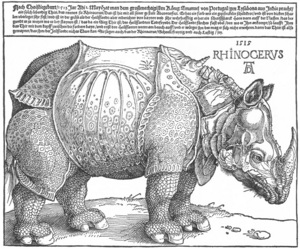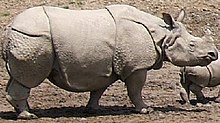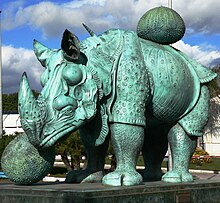用戶:如沐西風/Sandbox3
| 這是維基百科用戶頁 此頁面不是百科全書條目,也不是條目的討論頁。 若您在中文維基百科(網域名稱為zh.wikipedia.org)之外的網站看到此頁面,那麼您可能正在瀏覽一個鏡像網站。 請注意:鏡像網站中的頁面可能已經過時,且頁面中涉及的用戶可能與該鏡像網站沒有任何關係。 若欲造訪原始頁面,請點擊這裏。 |
| 美術沙盒 現在條目:丟勒的犀牛 參考譯文:en:Dürer's Rhinoceros |
| 犀牛 | |
|---|---|
 | |
| 藝術家 | 阿爾布雷希特·丟勒 |
| 年份 | 1515年 |
| 類型 | 木板畫 |
《丟勒的犀牛》是一幅由德國畫家兼版畫家阿爾布雷希特·丟勒於1515年作造的木板畫。[1]作品建基於一幅印度犀牛的素描,由不知名畫家所畫的,畫上並寫有描述。而畫中的犀牛則是早幾年來到里斯本的,是自從羅馬帝國以來第一個活生生的例子。然而,丟勒本人從沒見過那隻犀牛的實體。在1515年末,葡萄牙國王曼紐爾一世把這隻動物送贈給教宗利奧十世作為禮物,但牠在1516年初一次在意大利海岸所發生的海難中死去。自此以後,歐洲再沒見過活生生的犀牛的紀錄,直至到1579年左右才有第二隻犀牛從印度送到西班牙[[]]的宮廷去。[2][3]
儘管畫中犀牛的構造並不正確,但丟勒的版畫卻瘋魔了整個歐洲,並在接下來的三個世紀被大量拷貝。在十八世紀晚期以前,這幅畫依然被認為是表達着犀牛的真正模樣。最終,作品被後來一些更真實的素描與繪畫所取代,尤其是有關犀牛克拉拉的繪圖。有人曾這樣說:「再沒有動物圖畫像《丟勒的犀牛》般對於藝術影響深厚。」[4]
從沒見過的動物
[編輯]1515年5月20日,一隻印度犀牛從遠東被運到里斯本。早在1514年初,葡屬印度的總督Alfonso de Albuquerque派遣大使到坎貝﹝即今天的古傑拉特﹞的統治者蘇丹Muzafar二世那裏去,尋求准許他可以在Diu上興建堡壘。任務最終以失敗告吹,但雙方卻交換了外交禮物,當中包括了犀牛。[5]在當時,the rulers of different countries would occasionally send each other exotic animals to be kept in a menagerie. The rhinoceros was already well accustomed to being kept in captivity. De Albuquerque decided to forward the gift, known by its Gujerati name of ganda, and its Indian keeper, named Ocem, to King Manuel I of Portugal. It sailed on the Nossa Senhora da Ajuda,[6] which left Goa in January 1515.[7] The ship, captained by Francisco Pereira Coutinho,[8] and two companion vessels, all loaded with exotic spices, sailed across the Indian Ocean, around the Cape of Good Hope and north through the Atlantic, stopping briefly in Mozambique, Saint Helena and the Azores.

After a relatively fast voyage of one hundred and twenty days, the rhinoceros was finally unloaded in Portugal, near the site where the Manueline Belém Tower was under construction. The tower was later decorated with gargoyles shaped as rhinoceros heads under its corbels.[9] A rhinoceros had not been seen in Europe since Roman times: it had become something of a mythical beast, occasionally conflated in bestiaries with the "monoceros" (unicorn), so the arrival of a living example created a sensation. In the context of the Rennaissance, it was a piece of Classical Antiquity which had been rediscovered, like a statue or an inscritoin.
The animal was examined by scholars and the curious, and letters describing the fantastic creature were sent to correspondents throughout Europe. The earliest known image of the animal illustrates a poemetto by Florentine Giovanni Giacomo Penni, published in Rome on 13 July 1515, less than 8 weeks after its arrival in Lisbon.[10]. The only known copy of the original published poem is held by the Biblioteca Colombina in Seville.
The exotic animal was housed in King Manuel's menagerie at the Ribeira Palace in Lisbon, separate from his elephants and other large beasts at the Estãos Palace. On Trinity Sunday, 3 June, Manuel arranged a fight between the rhinoceros and a young elephant from his collection, to test the account by Pliny the Elder that the elephant and the rhinoceros are bitter enemies.[11] The rhinoceros advanced slowly and deliberately towards its foe; the elephant, unaccustomed to the noisy crowd that turned out to witness the spectacle, fled the field in panic before a single blow was struck.[12][13]

Manuel decided to give the rhinoceros as a gift to the Medici Pope, Leo X. The King was keen to curry favour with the Pope, to maintain the papal grants of exclusive possession to the new lands that his naval forces had been exploring in the Far East since Vasco da Gama discovered the sea route to India around Africa in 1498. The previous year, the Pope had been very pleased with Manuel's gift of a white elephant, also from India, which the Pope had named Hanno. Together with other precious gifts of silver plate and spices, the rhinoceros, with its new collar of green velvet decorated with flowers, embarked in December 1515 for the voyage from the Tagus to Rome.[14] The vessel passed near Marseille in early 1516. King Francis I of France was returning from Saint-Maximin-la-Sainte-Baume in Provence, and requested a viewing of the beast. The Portuguese vessel stopped briefly at an island off Marseilles,[15] where the rhinoceros disembarked to be observed by the King on 24 January.

After resuming its journey, the ship was wrecked in a sudden storm as it passed through the narrows of Porto Venere, north of La Spezia on the coast of Liguria. The rhinoceros, chained and shackled to the deck to keep it under control, was unable to swim to safety and drowned. The carcass of the rhinoceros was recovered near Villefranche and its hide was returned to Lisbon, where it was stuffed. Some reports say that the mounted skin was sent to Rome, arriving in February 1516, to be exhibited impagliato (Italian for "stuffed with straw"), although such a feat would have challenged 16th-century methods of taxidermy. In any event, the rhinoceros did not cause a popular sensation in Rome like the living beast had in Lisbon, although a rhinoceros was depicted in contemporary paintings in Rome by Giovanni da Udine and Raphael.[16][17]
If a stuffed rhinoceros arrived in Rome, its fate remains unknown: it may have been removed to Florence by the Medici, or it may have been destroyed in the sack of Rome in 1527. Its story was the basis for Lawrence Norfolk's 1996 novel The Pope's Rhinoceros.[18]
丟勒的木板畫
[編輯]
A Moravian merchant, Valentim Fernandes, saw the rhinoceros in Lisbon shortly after it arrived and wrote a letter describing it to a friend in Nuremberg in June 1515. The original letter in German has not survived, but a copy in Italian is held in the Biblioteca Nazionale Centrale in Florence.[20] A second letter of unknown authorship was sent from Lisbon to Nuremberg at around the same time, enclosing a sketch by an unknown artist. Dürer saw the second letter and sketch in Nuremberg. Without ever seeing the rhinoceros himself, Dürer made two pen and ink drawings,[21] and then a woodcut was created from the second drawing, the process of fabrication making one a reflection of the other.[17][22]
The German inscription on the woodcut, drawing largely from Pliny's account,[11] reads:
| “ | On the first of May in the year 1513 AD [sic], the powerful King of Portugal, Manuel of Lisbon, brought such a living animal from India, called the rhinoceros. This is an accurate representation. It is the colour of a speckled tortoise,[23] and is almost entirely covered with thick scales. It is the size of an elephant but has shorter legs and is almost invulnerable. It has a strong pointed horn on the tip of its nose, which it sharpens on stones. It is the mortal enemy of the elephant. The elephant is afraid of the rhinoceros, for, when they meet, the rhinoceros charges with its head between its front legs and rips open the elephant's stomach, against which the elephant is unable to defend itself. The rhinoceros is so well-armed that the elephant cannot harm it. It is said that the rhinoceros is fast, impetuous and cunning.[24] | ” |

Dürer's woodcut is not an entirely accurate representation of a rhinoceros. He depicts an animal with hard plates that cover its body like sheets of armour, with a gorget at the throat, a solid-looking breastplate, and rivets along the seams; he also places a small twisted horn on its back, and gives it scaly legs and saw-like rear quarters. None of these features is present in a real rhinoceros.[25][26] It is possible that a suit of armour was created for the rhinoceros's fight against the elephant in Portugal, and that these features depicted by Dürer are parts of the armour.[27] Alternatively, Dürer's "armour" may represent the heavy folds of thick skin of an Indian rhinoceros, or, as with the other inaccuracies, may simply be misunderstandings or creative additions by Dürer.[28] Dürer also draws a scaly texture over the body of the animal, including the "armour". This may be Dürer's attempt to reflect the rough and almost hairless hide of the Indian rhinoceros, which has wart-like bumps covering its upper legs and shoulders. On the other hand, his depiction of the texture may represent dermatitis induced by the rhinoceros' close confinement during the four-month journey by ship from India to Portugal.[29]

A second woodcut was created by Hans Burgkmair in Augsburg around the same time as Dürer's in Nuremberg. Burgkmair corresponded with merchants in Lisbon and Nuremberg, but it is not clear whether he had access to a letter or sketch as Dürer did, perhaps even Dürer's sources, or saw the animal himself in Portugal.[30] His image is truer to life, omitting Dürer's more fanciful additions and including the shackles and chain used to restrain the rhinoceros;[30] however, Dürer's woodcut is more powerful and eclipsed Burgkmair's in popularity. Only one copy of Burgkmair's image has survived,[31] whereas Dürer's original single block print was copied many times. Dürer produced a first printing of his woodcut in 1515, distinguished by only five lines of text in the heading,[8] and many further printings followed after Dürer's death in 1528, including two printings in the 1540s, and a further two in the late 16th century.[32] Later printings have six lines of descriptive text.引用錯誤:沒有找到與<ref>對應的</ref>標籤 The original wood block continued to be used, even though later printings are marred by woodworm holes and a crack through the rhino's legs.[33]

Despite its errors, the image remained very popular,[26] and was taken to be an accurate representation of a rhinoceros until the late 18th century. Dürer may have deliberately chosen to create a woodcut, rather than a more refined and detailed copperplate engraving, to ensure it would be suitable for mass-market printing.[33] Images derived from it were included in naturalist texts, including Sebastian Münster's Cosmographiae (1544), Conrad Gessner's Historiae Animalium (1551), Edward Topsell's Histoire of Foure-footed Beastes (1607) and many others. A rhinoceros that was clearly based on Dürer's woodcut was chosen by Alessandro de' Medici as his emblem in June 1536, with the motto "Non buelvo sin vencer" (old Spanish for "I shall not return without victory").[34] A sculpture of a rhinoceros based on Dürer's image was placed at the base of a 70-foot (21 m) high obelisk designed by Jean Goujon and erected in front of the Church of the Sepulchre in the rue Saint-Denis in Paris in 1549 to welcome the arrival of the new King of France, Henri II.[35] A similar rhinoceros, in relief, decorates a panel in one of the bronze west doors of Pisa cathedral. The rhinoceros was depicted in numerous other paintings and sculptures, and became a popular decoration for porcelain. The popularity of the inaccurate Dürer image remained undiminished despite an Indian rhinoceros spending eight years in Madrid, from 1579 to 1587 (although a few examples of a print of the Madrid rhinoceros created by Philippe Galle in Antwerp in 1586, and derivative works, have survived), and the exhibition of a live rhinoceros in London a century later, from 1684–86, and of a second individual after 1739.[36]

The pre-eminent position of Dürer's image and its derivatives declined from the mid- to late-18th century, when more live rhinoceroses were transported to Europe, shown to the curious public, and depicted in more accurate representations. Jean-Baptiste Oudry painted a life-size portrait of Clara the rhinoceros in 1749, and George Stubbs painted a large portrait of a rhinoceros in London around 1790. Both of these paintings were more accurate than Dürer's woodcut, and a more realistic conception of the rhinoceros gradually started to displace Dürer's image in the public imagination. In particular, Oudry's painting was the inspiration for a plate in Buffon's encyclopedic Histoire naturelle, which was widely copied.[37] In 1790, James Bruce's travelogue Travels to discover the source of the Nile dismissed Dürer's work as "wonderfully ill-executed in all its parts" and "the origin of all the monstrous forms under which that animal has been painted, ever since". Even so, Bruce's own illustration of the African white rhinoceros, which is noticeably different in appearance to the Indian rhinoceros, still shares conspicuous inaccuracies with Dürer's work.[38] Semiotician Umberto Eco argues that Dürer's "scales and imbricated plates" became a necessary element of depicting the animal, even to those who might know better, because "they knew that only these conventionalized graphic signs could denote «rhinoceros» to the person interpreting the iconic sign." He also notes that the skin of a rhinoceros is rougher than it visually appears and that such plates and scales portray this non-visual information to a degree.[39] Until the late 1930s, Dürer's image appeared in school textbooks in Germany as a faithful image of the rhinoceros;[4] in German, the Indian rhinoceros is still called the Panzernashorn, or "armoured rhinoceros". It remains a powerful artistic influence, and was the inspiration for Salvador Dalí's 1956 sculpture, Rinoceronte vestido con puntillas, which has been displayed at Puerto José Banús in Marbella since 2004.
註解
[編輯]- ^ 有資料錯誤地say 1513, copying a typographical error made by Dürer in one of his original drawings and perpetuated in his woodcut. (Bedini, p.121.)
- ^ Clarke, chapter 2.
- ^ A street in Madrid was named Abada (rhinoceros in Portuguese) after this animal, that had a curious life too: [1]. [2] (in Spanish)
- ^ 4.0 4.1 Quoted in Clarke, p.20.
- ^ Bedini, p.112.
- ^ Clarke, p.16.
- ^ Bedini, p.113.
- ^ 8.0 8.1 História do famoso rhinocerus de Albrecht Dürer, Projecto Lambe-Lambe (葡萄牙文).
- ^ See Clarke, p.19, for a photograph of a gargoyle.
- ^ Giovanni Giacomo Penni, Forma e natura e costumi de lo rinocerote (...). See Ugo Serani, Etiopicas 2 (2006) ISSN 1698-689X [3] for the original text in Italian and a translation into Spanish.
- ^ 11.0 11.1 Latin original and English translation of Chapter 29, Book VIII of Pliny's Naturalis Historia.
- ^ Bedini, p.118.
- ^ Albrecht Dürer, The Rhinoceros, a drawing and woodcut, from the British Museum.
- ^ Bedini, p.127.
- ^ The Frioul archipelago consists of four main islands. Bedini, p.128, nominates either Pomègues or Ratonneau; the other possibilities are the small island of If, now occupied by the Château d'If, or Tiboulain.
- ^ Bedini, p.132.
- ^ 17.0 17.1 Gessner's Hyena and the Telephone Game, Manda Clair Jost, 2002 (PDF, 21 pages).
- ^ Biography of Lawrence Norfolk from the British Arts Council; Lawrence Norfolk, 1996, The Pope's Rhinoceros: A Novel, Harmony, ISBN 051759532X.
- ^ Clarke, caption to colour plate I, p.181.
- ^ Bedini, p.120 and fn.10.
- ^ One later acquired by Sir Hans Sloane and now held by the British Museum.
- ^ The woodcut was probably, per Quammen, p.204, carved by a specialist craftsman known as a Formschneyder, under Dürer's supervision.
- ^ Bedini, p.121; some versions translate Krot as "toad", but Schildkrot most likely refers to a tortoise.
- ^ Rough translation of the German original. See also a French translation in the doctoral thesis of Bruno Faidutti at l'université Paris XII: La licorne et le rhinocéros, chapter 3.2, illustration 10, November 1996. (法文); and a similar translation in Clarke, p.20.
- ^ Group of History and Theory of Science - Dürer's Rhinoceros, State University of Campinas, Brazil.
- ^ 26.0 26.1 Dürer's Rhinoceros, Kallisti Digital Publishing, 7 March 2003.
- ^ Suggested by Glynis Ridley (2004), Clara's Grand Tour: Travels with a Rhinoceros in Eighteenth-century Europe, Atlantic Monthly Press, ISBN 184354010X, a study of Clara the rhinoceros; however, there is no mention of this in Bedini.
- ^ Dürer was living near the armourer's quarter in Nuremberg, Schmeidegasse, and was designing armour at about the same time; this aspect may therefore be a creative conceit. (Clarke, p.20.)
- ^ Commentary on a plate from Conrad Gessner's Mammals, folio 131 verso, from the Humanities Media Interaction Project, Keio University, Japan.
- ^ 30.0 30.1 Bedini, p.121.
- ^ Held by the Graphische Sammlung Albertina, Vienna.
- ^ Clarke, p.23.
- ^ 33.0 33.1 Quammen, p.206.
- ^ Bedini, p.192.
- ^ Bedini, p.193.
- ^ Clarke, chapter 2 and 3.
- ^ Clarke, p.64.
- ^ Alperson, Philip A. The Philosophy of the Visual Arts. Oxford University Press US. 1992: p. 80. ISBN 0195059751.
- ^ Eco, Umberto. Theory of Semiotics. Indiana University Press. 1978: p. 205. ISBN 253202175.
參考資料
[編輯]
- Bedini, Silvano A. The Pope's Elephant. Manchester: Carcanet Press. 1997. ISBN 1857542770. (particularly Chapter 5, "The Ill-Fated Rhinoceros")
- Clarke, T. H. The Rhinoceros from Dürer to Stubbs: 1515–1799. London: Sotheby's Publications. 1986. ISBN 0856673226. (particularly Chapter 1, "The first Lisbon or 'Dürer Rhinoceros' of 1515")
- David Quammen (2000), The Boilerplate Rhino: Nature in the Eye of the Beholder, Scribner, ISBN 0684837285 (particularly p.201-209, The Boilerplate Rhino, previously published in this "Natural Acts" column in Outside magazine, June 1993)
- This article was originally based on a translation of part of an article of the French Wikipedia, dated 2006-07-18
外部連結
[編輯]- Albert Dürer, by T. Sturge Moore, from Project Gutenberg
- Vector Graphic Adaptions of Dürer's Rhinoceros in Adobe Illustrator Format by LAFKON (under a creative commons license)
- The rhinoceros by Albrecht Dürer, in the collection of the National Gallery of Victoria.
-{{Link FA|de} -{{Link FA|en} -{{Link FA|es} -{{Link FA|fr}
-[[Category:著名犀牛] -[[Category:文藝復興時期作品] -[[Category:1515年作品] -[[Category:大英博物館收藏品] -[[Category:印刷品 (美術)] -[[Category:阿爾布雷希特·丟勒]
-[[de:Rhinocerus (Dürer)] -[[en:Dürer's Rhinoceros] -[[eo:Rinocero de Dürer] -[[es:Rinoceronte de Durero] -[[fi:Sarvikuono (Dürer)] -[[fr:Rhinocéros de Dürer] -[[nl:Rhinocerus] -[[pt:Rinoceronte de Dürer] -[[ru:Носорог (гравюра Дюрера)]
